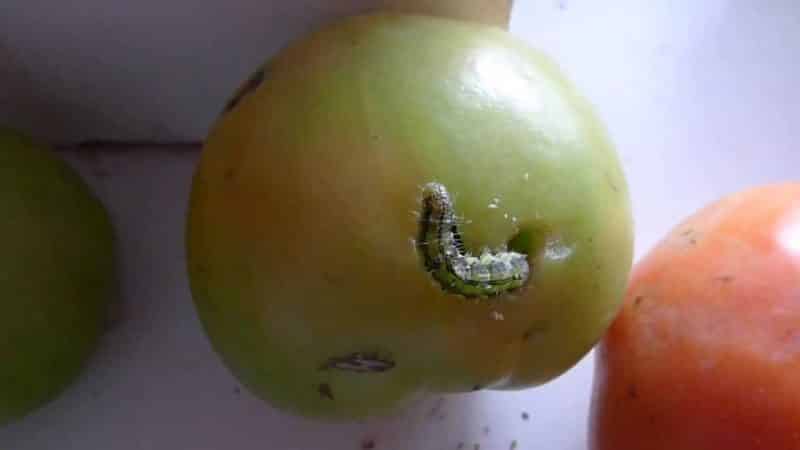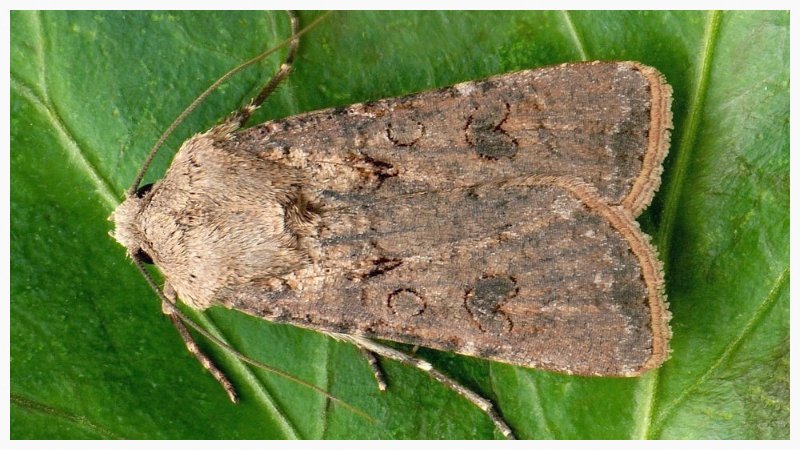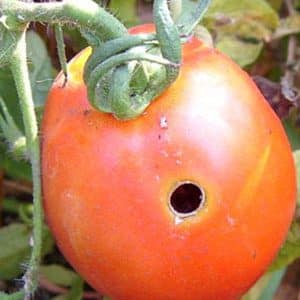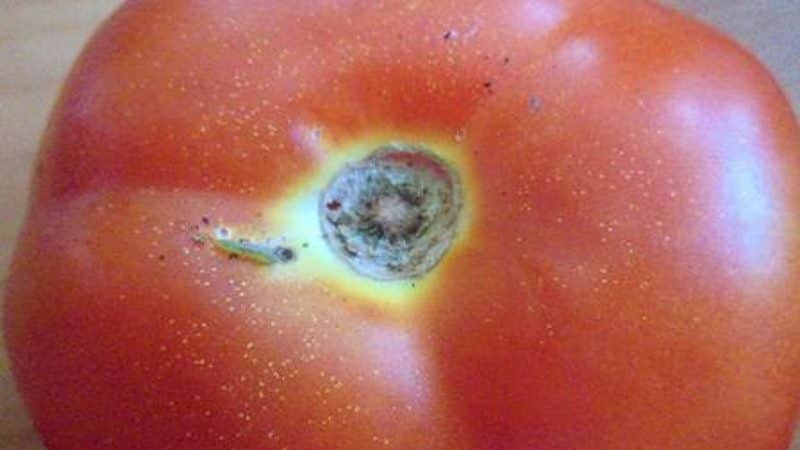We fight pests easily and effectively: how to treat wormy tomatoes to save your harvest
Tomato pests can destroy the crop both in open ground and in greenhouses. Experienced vegetable growers have learned to recognize types of pests and know how best to destroy them.
How to save a crop from a worm, what methods to use if roots, stems and fruits are damaged, how not to harm the plants - you will learn about this from our article.
Signs of worm damage to tomatoes
To determine whether tomatoes are wormy or not, examine them carefully. Pay special attention to the cutting, since it is through it that pests most often penetrate into the fruit. If there are worms inside the tomato, you will find small holes that look like tunnels.
Some insects feed on the stem of the plant. In this case, tissue damage can be seen, and ovaries and flowers may fall off.
If the roots are damaged, the plant begins to wither and dry out. It is difficult to recognize the true cause of its death - upon examination, it may seem that the tomato lacked moisture or fertilizer.

What kind of worms can there be?
It is impossible to detect pests during the day; their activity phase falls at night. Pests prefer green fruits, but some species feed on roots and stems.
Types of pests:
- scoop;
- click beetle larva or wireworm;
- May beetle larva or beetle;
- root-knot nematode.
How to recognize
Caterpillars Cutworms attack the above-ground part of the tomato.Adults resemble large gray-brown moths with patterns on their wings. The caterpillars are brown, greenish, and black in color. The insect begins to act in the spring, laying eggs on stems, leaves and ovaries. In one season, 3-4 generations of pests can grow.

Some cutworm species feed on stems, leaves and ovaries, while others prefer fruits. They gnaw a hole in the tomato through which they penetrate and completely eat the pulp.
The larvae of the click beetle are called wireworms because of their external resemblance to wire. The size of the individual is 10-30 mm, the body is oblong with a yellow color. The pest attacks the root system, but sometimes its target is stems with fruits. Factors that provoke its appearance are increased soil humidity and acidity.
May beetle larvae are white in color and look like thick caterpillars with a light orange head. The larvae feed exclusively on roots, causing the plant to die.
The root-knot nematode is a round worm 1 mm long. It lives in the roots of the plant, which is why thickenings appear on them, similar to tubers. As a result, the plant begins to lag behind in development, withers and dries out.
A novice gardener may believe that the death of the plant was due to a lack of minerals, moisture and fertilizers. The pest can be detected only by digging up the bush and examining the root system.
Reference. In Russia, tomatoes are most often affected by the cotton bollworm.
Features of getting rid of worms
When choosing a method of combating caterpillars, it is worth taking into account the characteristics of the plants and the affected area - an incorrectly selected and incorrectly used product will not only be useless, but also lead to crop loss.
In fruits
Fruits in which caterpillars have taken up residence are not suitable for food. Pests eat them from the inside, and what remains undergoes a process of rotting.
In the stems
It is possible and necessary to fight insects that attack stems. Some pests gnaw the tops before fruiting, and then move on to the fruits. However, the plant must be treated with caution, given the waiting period for some drugs.
In the roots
Getting rid of caterpillars in the root system of a plant is not easy. Pests are able to remain in the soil for a long time and attack new plants. Sometimes the appearance of insects on the site is provoked by the gardener himself - when he brings and uses untreated soil or manure in the beds.
Read also:
Why is bollworm on corn dangerous?
Tomato variety “Giant Novikova”, resistant to diseases and pests.
Fighting methods
Experienced vegetable growers advise using safe traditional methods at the beginning of the fight, but if the situation is advanced, biological and chemical preparations will be needed. Agricultural practices will protect against the reappearance of caterpillars.
Biological
In pest control, gardeners often give preference to biological products. They are safe and do not contribute to the accumulation of harmful substances in fruits. The principle of operation is the use of microorganisms. The products are equally effective against all types of caterpillars and worms.
Preparations against pests:
- "Lepidocide";
- "Agravertine";
- "Bitoxibacillin";
- "Aktofit";
- "Fitoverm".
Chemical
Chemicals are the most effective. However, they are used only in cases where other methods have failed.
The following drugs are used against cutworms:
- "Aktellik";
- "Iskra M"
- "Inta-Vir";
- "Fufanon";
- "Decis";
- "Alatar";
- "Avant."
Remedies for cockchafer and wireworm larvae:
- "Aktara";
- "Bazudin";
- "Anti-Khrushch."
There are no chemicals against root-knot nematodes; the pest is extremely difficult to remove from the soil.
Important! Chemical treatment is possible during the growing season, before fruits form on the plant. The waiting period is 20-30 days.
Folk
The experience of gardeners shows that simple and affordable “home” methods can clear the area of unwanted insects:
- Collecting caterpillars by hand - This method is used when the use of chemicals is stopped.
- To repel insects, the row spaces are watered with a solution of ammonia.
- Bleach is used against root-knot nematodes - it is added to the holes before planting seedlings.
- Onion peels or mustard powder are good protection against wireworms. The components are introduced into the well.
- Lures for adults. A plastic cup or bottle is filled with fermented jam, syrup or kvass, and then hung over the beds. Insects caught in the trap are destroyed.
Agrotechnical

Techniques that will allow you to get rid of caterpillars without the use of drugs:
- planting cruciferous crops, elderberry and lupine around the perimeter of the plot;
- mulching beds with wood shavings or pine needles;
- deep digging of the soil;
- removing weeds from the garden.
The root-knot nematode is difficult to remove, but you can get rid of it by planting onions, garlic and calendula next to the tomatoes.
Important! Wormy fruits should not be left on the site; they must be destroyed or buried away from the plantings at a depth of 30 cm.
How to spray tomatoes against worms
The experience of vegetable growers shows that caterpillars are well repelled by infusions of garlic, burdock, calendula, wormwood and tobacco dust:
- Garlic infusion - chop the head or bunch of arrows and place in a liter jar. The contents of the container are poured with boiling water and left for three days. Before use, the infusion is filtered. For 10 liters of water, 0.5 cups of infusion is enough. Process after 7-10 days until the pests are completely gone.
- Wormwood decoction — fill the bucket 1/3 full with fresh wormwood, add water and simmer over low heat for 30 minutes. Then the liquid is infused for two days, filtered and diluted with water in a ratio of 1 to 10. The beds are sprayed with the decoction 2-3 times a month.
- Infusion of tobacco dust — Dissolve 300 g of dust in a bucket of hot water and leave for 24 hours. The procedure is carried out every 10 days until the caterpillars disappear.
- Salt solution - 100 g of salt is dissolved in 10 liters of water, after half an hour the liquid is filtered. Use the product no more than once a month.
- Potato tops infusion - 1 kg of fresh stems pour 10 liters of boiling water. The liquid is infused for one day and filtered before use. The infusion is used every 10 days until the insects disappear completely.
Before use, add crushed or melted laundry soap to the solution - with it, the products will stick to the leaves of the plant for a long time.
How to properly spray the beds
Treatment against insects is carried out at an air temperature of +20 ° C. For spraying use a fine spray. The solution is applied to dry leaves, the liquid should get on both sides of the leaf and the stem.
If there is no spray bottle, water the tomatoes with the solution from above, and then spray the beds with a broom, trying to get the liquid onto the inside of the leaf.
Preventive measures
It is worth taking care of protecting the crop from pests even at the stage of sowing seeds:
- purchase seeds from trusted producers;
- choose varieties that are resistant to pests;
- regularly weed the beds to remove weeds;
- dig up the ground at the beginning and after the season;
- in the spring, treat the soil with a weak solution of manganese or boiling water;
- do not thicken the beds;
- Fertilize the beds with mineral fertilizers.
Secrets of experienced gardeners

Pest control is difficult, but there are a few secrets that will help you quickly eliminate this problem:
- Manure - a favorite environment for many pests. Caterpillars are attracted to this fertilizer, which increases the risk of introducing pests into your area. If a vegetable grower has already encountered the problem of worms in the past, it may be worth switching to mineral fertilizers.
- Use mosquito repellents to prevent insects from entering the greenhouse. mesh or tulle.
- frogs - many vegetable growers specifically lure amphibians or birds - natural enemies of caterpillars - to their plot. This method will not protect against caterpillars attacking fruits and roots.
- Carnivorous animals are sold in stores for summer residents entomophagous insects, another natural enemy of many pests.
- Raw vegetable trap - used against wireworms. A few days before planting seedlings, pieces of raw potatoes and carrots strung on sticks are buried in the area. After a couple of days, the sticks are removed along with the insects that have collected on the pieces of vegetables.
- 2 months before planting seedlings in the beds, sow white mustard seeds. When it's time to plant tomatoes, dig up the area along with mustard seedlings. Once the transplanting is completed, irrigate the seedlings with a weak mustard solution.
- Don't neglect feeding plants. The victims of caterpillars are often stunted, deprived plants.
Conclusion
Caterpillars are voracious and can destroy an entire crop. A vegetable grower who is faced with this problem will have to make efforts not only to expel pests, but also to protect the plants in the new season. Many insects remain in the ground, so preventive measures should not be neglected.
If precautions do not help, folk methods will come to the rescue. How to treat the beds? There are many options - infusions and decoctions of herbs are equally disliked by all types of caterpillars. You can also use biological and chemical preparations, but each gardener must assess the need and possible risks of their use.